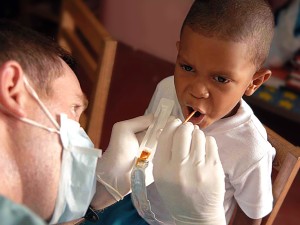
A Lifetime of Great Dental Health Must Start Early
By Dr. Marshall Dawer, M.D. M.S. F.A.C.P. ABEM
Market Medical Director, UnitedHealthcare of North Texas
February is National Children’s Dental Health Month, a reminder that good oral health is crucial to good overall health.
Tooth decay is largely preventable, yet it ranks as the most common chronic disease among children, according to the Centers for Disease Control and Prevention. A recent survey by The Pew Center on the States gave Texas a “B” in managing children’s oral health based on key measures such as optimally fluoridated water and availability of school-based dental programs.
Some people believe baby teeth are not overly important, yet decay even in baby teeth can lead to speech problems, oral infections and discolored, crooked and damaged adult teeth. It’s important to keep baby teeth healthy and in place to ensure permanent teeth come in properly.
Maintaining proper oral health among children is relatively easy. For example:
For baby’s teeth and gums: Never put baby to bed with a bottle of milk, formula, fruit juice or sweetened liquid. When these liquids pool in a baby’s mouth, they form a sugary film on the baby’s teeth, leading to decay and infection.
Starting at birth, clean the baby’s gums with water and a soft cloth or child-sized tooth brush. Once a child reaches age 2, parents can start brushing a baby’s teeth with a soft bristled toothbrush and a smear-sized dab of fluoride toothpaste (no larger than a grain of rice), making sure to teach the toddler to spit out the toothpaste.
Schedule the baby’s first dental visit when the first tooth comes in, usually between the child’s first six to 12 months.
For children’s teeth and gums: Help your child brush twice a day with a small amount of fluoride toothpaste; for children ages 3 to 6, this means a pea-sized dab. Make sure your child does not swallow toothpaste, which may expose them to too much fluoride.
Begin flossing when back teeth begin to come in. Toothbrush bristles cannot reach between teeth, leaving those teeth vulnerable to bacteria and decay.
Limit sugary snacks and drinks between meals. When sugar comes in contact with teeth, decay-causing bacteria can produce acids that damage your child’s teeth. Encourage children to eat healthy snacks, such as fruits and vegetables.
Take your child to the dentist regularly and ask about fluoride supplements, which make the tooth enamel strong and help protect it from decay. For most children, that means visiting the dentist twice a year.
Sealants are plastic coatings placed on back teeth to protect them from decay, and they are usually covered as a preventive service by many dental plans, requiring little or no out-of-pocket costs. Ask the dentist about placing sealants for your child once he/she turns 6, when molars first come in.
Be sure to take advantage of your health plan’s preventive dental benefit and visit your dentist regularly. By taking a few simple steps, you can start your children down the road of good oral health.




